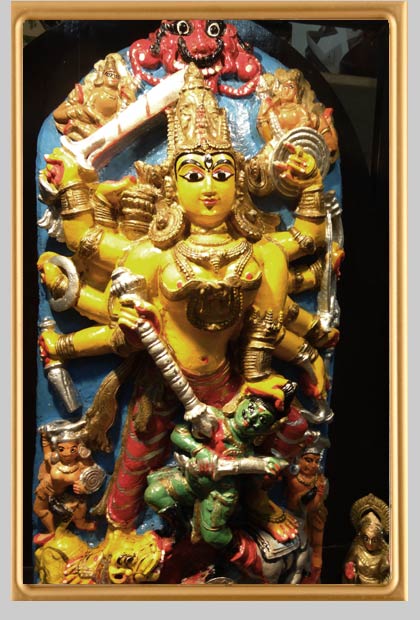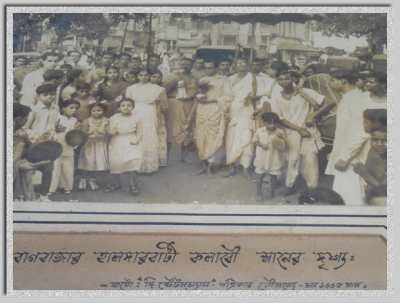

The Durga Puja celebration of Baghbazar Haldar house is one of oldest and historically significant household Durga Puja of Kolkata. The idol is worshipped daily for the last 453 years.  The Durga idol at Haldarbari is made of Kasthipathar (Philosopher’s Stone) instead of clay. Historical evidences say that one of the earlier descendants of Haldar family residing at Nawpara of Chandannagar went for pleasure trip to a palace named Sahebpur located near Balasore of Odisha. While staying there, some of the persons in the group had a dream that a Goddess is instructing them to excavate her idol which is buried about 14 feet deep beneath the earth inside the house of a Muslim fisherman. The Goddess also instructed to worship her daily. The Durga idol at Haldarbari is made of Kasthipathar (Philosopher’s Stone) instead of clay. Historical evidences say that one of the earlier descendants of Haldar family residing at Nawpara of Chandannagar went for pleasure trip to a palace named Sahebpur located near Balasore of Odisha. While staying there, some of the persons in the group had a dream that a Goddess is instructing them to excavate her idol which is buried about 14 feet deep beneath the earth inside the house of a Muslim fisherman. The Goddess also instructed to worship her daily.The Haldar family excavated the said place as per divine instruction. The idol was that of Devi Durga as Mahishashurmardini. Unlike many such excavated idol, this was absolutely perfect. Even the ring on the deity’s left hand has been sculpted with intricate details. As mentioned earlier, the idol was that of Dura with ten hands carved in Kasthipathar. With a lion as her Bahna (Carrier), the bejeweled Goddess is seen here vanquishing the demon Mahishashura. Above her head is the face of Mahakal, and near her feet are Jaya and Bijoya. The entire idol is seated on a lotus. It is evident from the structure and style of the deity that it has been sculpted during the Pala era of Bengal. From this fact one can estimate that the age of the idol is around 600 to 700 years. Almost similar idols can be seen at British Museum and Chandannagar Museum and Institute. However, they are not as unscratched as the idol of Haldarbari. There is also a similar idol at Kolkata Musuem, which also is not as perfect as the deity residing at Haldarbari. Historian Nikhil Sarkar and famous writer Sripantho have written about art work made during Pala era which can be mentioned in this respect. It can be assumed that about 500 years ago some Hindu devotee may have buried the idol deep under the ground to save it from Muslim religious fanatics. It is such assumed because if it was buried by any fanatic person of other religion it surely would have been damaged. Over the period of 500 years, the Muslim rule faded out and the British took control over the land. The history of next 200 years seemed to be have faded into the oblivion. The reference of the deity comes into context during the tenure of the most renowned descendant of Haldar family – Prankrishna Haldar. He was a reputed Zamindar and very close to the British Rulers. He has a collossal mansion at Chinsurah, which was later converted to a school. Reputed magazine of yesteryears –‘Calcutta Gazette’ on their issue dated 20th September 1807 describes Prankrishna Haldar as a famous person of Chuchura (Chinsurah). The magazine also mentions his request to all for joining the dance performance to be held at his residence during Durgapuja celebration. Also another magazine of the same period ‘Samachar Darpan’ describes him as “Babu among the Babus”. All extravagancy he showcased at that period used to be the best of the lot.  Prankrishna Haldar did not have any children of his own. Hwever, his nephew Nilmani Haldar was another renowned descendent of the family. There is a lane at Janbazar named Nilmani Haldar Lane. He was very cordial relationship with Rani Rasmani and her family. Prankrishna Haldar did not have any children of his own. Hwever, his nephew Nilmani Haldar was another renowned descendent of the family. There is a lane at Janbazar named Nilmani Haldar Lane. He was very cordial relationship with Rani Rasmani and her family.Perhaps one of the most learned person of the family was Nilmani Haldar’s son Nilratna Haldar. He was fluent in 22 languages. He became the Dewan of Bengal’s Salt Board. Nilratna Haldar was the editor of Bengal Herald which was published in 4 languages ( English, Bengali, Parsee and Hindi). He was known for being an eminent writer and a poet. Apart from Bengal Herald he was editor of a magazine named "Bangadut" which came out in 1829. Some of the books written by him are Kavita Ratnakar (1825), Jyotish (1825), Adristo Prakash (1826) and Bahudarshan (1826). Another notable descendant of Haldar family was Dharmdas Haldar,the step brother of Nilratna Haldar. By his sincere efforts, He staged several theatres relating to Babu Culture on the earlier undivided Thakurdalan of Haldar family. The next notable descendant of Haldar family was Rakhaldas Haldar. He was very religious and was one of the 52 direct domestic dosciples of Thakur RamkrishnaParamahansa. His name is mentioned in the book Ramakrishna Kathamrita. The Haldar family progressed towards the future under the guidance of LalRatanHaldar. He brought in the religious inspiration in the modern history of Haldar family. His two sons are PitambarHaldar and AmulyaratanHaldar. The different members Haldar Family are scattered over the various parts of the country for their profession. However on the days of DurgaPuja , they come together to enjoy the festival. The Haldarfamily get decked up for festivities. The Durga Puja which was once initiated once by their ancestors is presently being carried on with huge pomp and show under the guidance of devotee Devasish Haldar (son of Amulyaratan Haldar). |
Photographs & Content contributed by Baghbazar Haldar Bari Haldar Family @ 2017 |